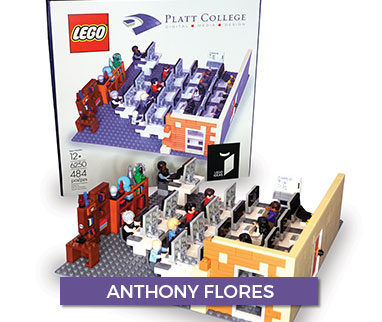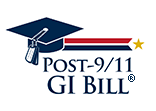





GRAPHIC DESIGN
ASSOCIATE OF APPLIED SCIENCE DEGREE
| PROGRAM SNAPSHOT | |
| Length of Program: | 16 Months |
| Length of a Core Classes: | 5-Weeks (100 hours) |
| General Education Classes: | 15-Weeks (30 hours) |
| All Course Times: | 8 am - 12 pm (Daily) |
| Class Sizes: | 24-Students Maximum |
| Equipment & Software provided while attending? | Yes |
| Prerequisites? | None |
| Course Load: | Full-Time |
| Accept VA Benefits? | Yes |
Students completing the 16-month, Associate of Applied Science Degree: Graphic Design program will have acquired the technical knowledge and the creative process principles necessary for an entry-level position in digital publishing and the commercial communication art fields.
- Learn Adobe Photoshop, Illustrator, InDesign, Social Media Platforms, and HTML / CSS
- 16-month degree program
- Small class size
- Complete design classes first
- One design class-at-a-time
- No application, parking or monthly material fees
- Software, books, and supplies included
- Locked tuition cost with no hidden fees
- Easy transfer credit evaluation
- VA approved
EMPLOYERS OF PLATT COLLEGE’S ALUMNI

THE MANY BENEFITS OF PLATT COLLEGE SAN DIEGO

Small Class Sizes
You receive closer, one-on-one, and tailored instruction while developing deep and lasting relationships with your fellow classmates.

On Campus Classes
Hands on, project based instruction with a curriculum designed and taught by industry professionals.

Inverted Curriculum
You complete design / technical courses before general studies, utilizing your newly acquired skills within your professional and personal life sooner.

No Hidden Costs
No application, parking or monthly material fees.

Accelerated Programs
Associate's Degree in 16 months. Bachelor's Degree in under 3 years.

Target One Class
You complete your technical / design classes one at a time. Focusing your creative attention on your target.
GRAPHIC DESIGN | A.A.S. DEGREE
COURSES & DESCRIPTIONS
SOFTWARE UTILIZED

Each Core course is 5-days-a-week, 5-weeks in length, Monday-Friday, 8am-12pm, 100 hours, hands-on, and completed one-at-a-time.
DD101 Digital Production
(4.50 semester credit hours/100 clock hours)
Digital Production (DD101) will focus on the hardware and software needed for Digital Print Production. The skills introduced are printing processes, use of color, layout techniques, basic Bezier curve construction, image editing, and in-depth use of the layout program used in the industry, Adobe InDesign. Also included are the basic business practices, freelance fundamentals, and working ethics. The course also offers basic software orientation in Adobe Illustrator and Photoshop along with introducing differences in Mac and PC platforms.
DES101 Design Basics
(4.50 semester credit hours/100 clock hours)
Design Basics (DES101) Introduces the formal elements of line, shape, color, texture and composition as well as the graphic principles of balance, repetition, scale, and unity. Students learn the organization, combination, or manipulation of these elements essential in achieving good design. Further topics introduce conceptual thinking, thumbnail development, research, and critique.
TYP101 Typography
(4.50 semester credit hours/100 clock hours)
Typography (TYP101) Introduces the students to the basic functions of Adobe InDesign. The emphasis is on typography in the study of graphic design and Digital Media design. The various assignments and exercises focus on the primary concerns and disciplines of typography such as choosing typefaces, modifying type through kerning, tracking, and leading. The choice of appropriate typefaces will also be addressed in the development of page layout and in the design of combination marks and logo design.
D102 Vector Graphics
(4.50 semester credit hours/100 clock hours)
Introduction to Vector Graphics (D102) is an introduction to vector illustration using Adobe Illustrator. Emphasis will be placed on mastering the pen tool, layers, combining shapes, gradients, gradient mesh and preparation of files for commercial printing. The course focuses on both technical as well as creative processes applied toward design applications.
DPD102 Digital Publishing
(4.50 semester credit hours/100 clock hours)
Digital Publishing (DPD102) is an introduction to page layout and design utilizing Adobe InDesign. It explores the design and creation of print-ready publications and introduces tools for effectively combining text and graphics. Some of the main focuses of the course include creative typography, graphic reproductions, and design and compositions principles.
P102 Raster Graphics
(4.50 semester credit hours/100 clock hours)
Introduction to Raster Graphics (P102) is an introduction to pixel editing software, which includes image acquisition, color theory, resolution for commercial printing, and photo retouching. Industry standards as established by the NAPP (National Association of Photoshop Professionals) are emphasized. Technical efficiency in Adobe Photoshop and creative approaches toward design problem resolution are goals of the course.
WD103 Introduction to Web
(4.50 semester credit hours/100 clock hours)
Introduction to Web Design and Development (WD103) introduces students to web design and development. Languages such as HTML & CSS will be covered using text editors. Graphics production for User Interface design and web page structure will also be covered. The course will aim to provide students with an understanding of the functionality of the Internet and the World Wide Web. Students will receive instruction that will enable them to create, edit and link HTML documents using a text editor. Students will learn to control and unify website styles using CSS. Students will also create web graphics and upload their personal websites and résumés to the World Wide Web using FTP.
GD103 Graphic Design for Advertising and Social Media
(4.50 semester credit hours/100 clock hours)
Graphic Design for Advertising and Social Media (GD103) course builds a familiarity with advanced graphic design trends, advertising theory and the use of social media and their application to both print and online graphics. Using presentations to develop client communication skills and standards for professional practice. To add an in-depth understanding of Social Media and how to fertilize its functions and analytics to further develop the marketability of the graphic design graduate.
P103 Digital Imaging
(4.50 semester credit hours/100 clock hours)
Digital Imaging (P103) covers advanced digital imaging concepts including file output, system configuration / calibration / troubleshooting, color correction, advanced photo manipulation and special effects. Advanced digital drawing techniques including masks, blends, and other advanced techniques are also covered. Students learn to integrate artwork created from various applications into the final project, as well as how to use the various applications more efficiently. Emphasis is placed on effective use of design. The flexibility of print design suitable for online platform is also introduced.
PP100 Portfolio Project
(4.50 semester credit hours/100 clock hours)
No transfer credit accepted for this course. As an outcome of the Portfolio Project, (Students at the AAS-level will create a print and online portfolio to demonstrate the skills and knowledge they have acquired throughout their program. Emphasis will be placed on presentation skills and strategies suitable for gaining employment.
All General Education Courses are completed within 15-weeks at the end of the Associate of Applied Science Degree: Graphic Design. Each General Education course is 5-weeks in length, Monday-Friday, 8am-12pm, and 30 hours. The 15-weeks is broken up into three, 5-week blocks.
ART103 Life Drawing
(2.00 semester credit hours/30 clock hours)
Life Drawing (ART103) is an introduction to creating drawings based on in-class observations of a range of artist’s models. The class also provides an overview of the drawing process as a form of visual thinking in relation to rendering the human figure. A variety of techniques and materials are used ranging from charcoal and graphite to color pastels.
ART104 Creative Concepts
(2.00 semester credit hours/30 clock hours)
Creative Conceptions (ART104) offers an exercise of analytical skills how they are applied in conceptualizing an art proposal applicable to any proposal. The course offers a hands-on approach including the principles and processes of design, concept development, and learning the basic fundamentals of character development for animation through traditional 2D and 3D media. Students will take their project through three phases: First comes idea development and basic conception, then the execution of the concepts in 2D and 3D formats and a formal presentation of the concept will conclude this creative analytical process. The goal of this course is to set a precedent for the creative process.
BUS104 Personal Financial Management
(2.00 semester credit hours/30 clock hours)
The Personal Financial Management course introduces students to the basic concepts, mathematics, and tools needed to plan for and achieve one’s personal and professional goals. Students will analyze the intricacies of interest rates, budgeting and saving, loans and consumer credit, investments in stocks, bonds and financial assets, annuities, insurance, taxes, business planning, estate planning, and retirement planning. This course also includes the Financial Avenue education program, based on the U.S. Department of the Treasury’s Financial Literacy and Education Commission’s financial education core competencies program.
COM105 Oral Communications
(2.00 semester credit hours/30 clock hours)
Oral Communication (COM105) aims to provide students with an understanding of oral communication theory and application. Students learn and practice several forms of communication including speaking to inform, speaking to persuade, historical speaking, and preparing presentations.
ENG105 English Composition
(2.00 semester credit hours/30 clock hours)
English Composition (ENG105) provides students with an overview of effective written communication methods for an academic setting. The student will develop skills in writing unified, coherent, well-developed essays using correct grammar and effective sentence structure.
ENS101 Environmental Science I
(2.00 semester credit hours/30 clock hours)
This course introduces students to ecology and evolution, covering principles of evolution at the molecular, organismal, and population levels. Evolutionary topics include natural selection, adaptation, speciation, and macroevolution. Also covers behavioral, population, and community ecology including applied problems in ecology, e.g., risk of extinction, impact of harvesting, role of species interaction, analysis of global change.
HUM140 History of Society in Art (Ancient to 15th Century)
(2.00 semester credit hours/30 clock hours)
History of Society Reflected in Art (Ancient to 15th Century) (HUM140) class explores the socio-economic development of society including worldviews, philosophies and achievements of each era during the Western Art Development epochs: Antiquity, Byzantine, Romanesque, Gothic, and Renaissance. The results of such exploration will offer the student a complete picture of the historical development of Western society.
HUM141 History of Society in Art (15th to 20th Century)
(2.00 semester credit hours/30 clock hours)
History of Society Reflected in Art (15th to 20th Century) (HUM141) explores the socio-economic development of society including worldviews, philosophies and achievements of each era during the Western Art Development epochs: Renaissance, Baroque, Rococo, Classicism, Romanticism, Impressionism and the rest of the so called –ism movements. The result of such exploration offers the student a complete picture of the historical development of the modern Western society.
CS110 Personal Branding
(2.00 semester credit hours/30 clock hours)
This class concentrates on developing communication concepts for creative careers by acquiring the ability to perform professionally and successfully at interviews and at project presentations. The class activities will revolve around the steps required to network, research, prepare, and interview for a real-world job opening. The objectives of the class are as follow: building interviewing skills, including informational interviews; video-recording and analyzing mock interviews, and building professional presentation skills (idea/art/project).
DOWNLOAD INFORMATION
| Registration Fee | $110 | |
| Term 1 - Term 3 | 45 Credits | $506.67 per credit |
| General Education | 18 credits | $455.56 per credit |
| All books, supplies, materials, printing, and software (Adobe Creative Cloud) | $2,300 | |











“The education I received at PCSD completely prepared me for the fast-moving field of Graphic Design, Digital Media, and Digital Video Editing. I landed a job with a design/digital media firm and never looked back.”